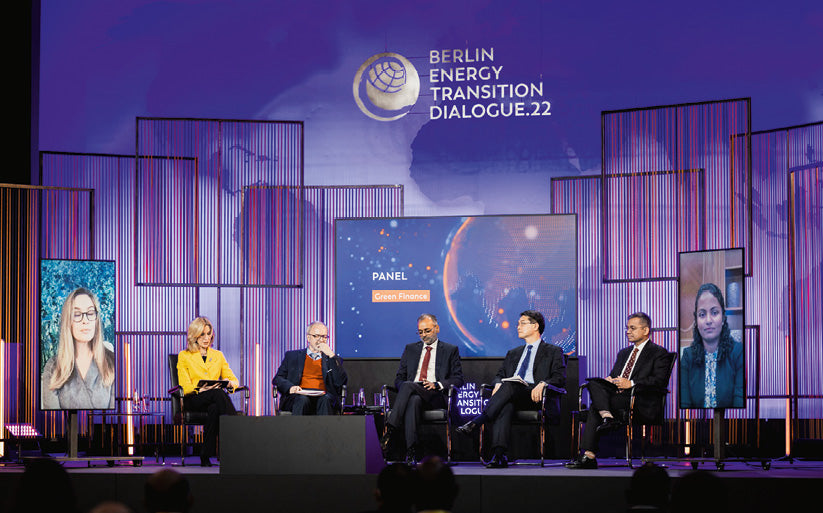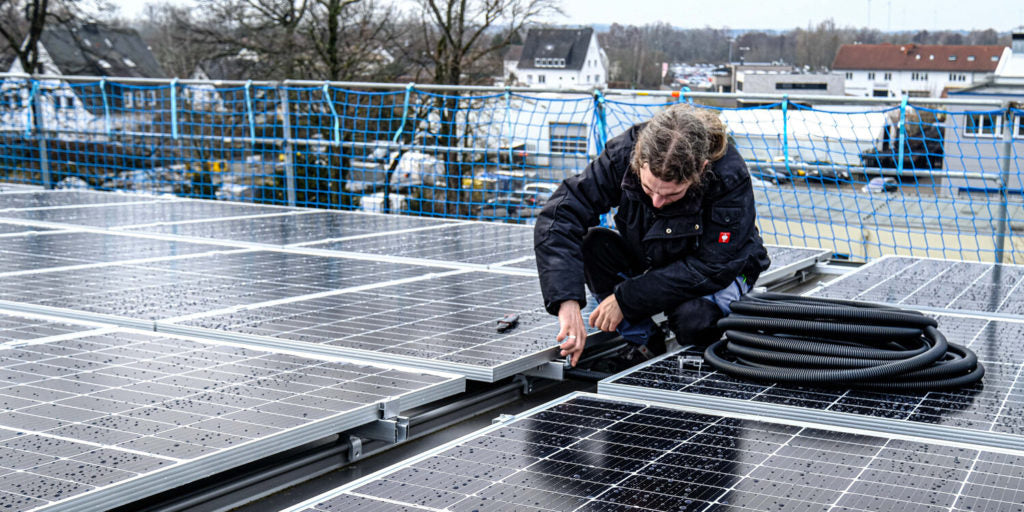https://www.pv-magazine.com/2022/06/25/the-weekend-read-the-stakes-are-high-for-solar-and-green-finance/
The weekend read: The stakes are high for solar and green finance

At the BETD, the green finance discussion centered on the role of the taxonomy in removing a major barrier to the flow of capital into renewables – namely the lack of knowledge of the mechanics of green finance.
Image: Photothek / Berlin Energy Transition Dialogue
From pv magazine 06/2022
 In 2020, the UP Initiative focused on green finance. At the time, Covid-19 was just beginning to hit the headlines with fears of unknown consequences on the political, social, and industrial level abounding. Two and a half years later, resiliency has been proven in many areas, not least in the renewables (and solar) industry, with record installation numbers continuing to be recorded. Indeed, according to the latest SolarPower Europe market outlook, 167.8 GW of solar was added in 2021, pushing cumulative global installations past the 1 TW mark.
In 2020, the UP Initiative focused on green finance. At the time, Covid-19 was just beginning to hit the headlines with fears of unknown consequences on the political, social, and industrial level abounding. Two and a half years later, resiliency has been proven in many areas, not least in the renewables (and solar) industry, with record installation numbers continuing to be recorded. Indeed, according to the latest SolarPower Europe market outlook, 167.8 GW of solar was added in 2021, pushing cumulative global installations past the 1 TW mark.
While the pandemic continues to affect us, particularly when it comes to global supply chains, the world is now facing a new crisis. The Ukrainian-Russian conflict has brought with it a new trifecta of fear: a humanitarian disaster; soaring inflation which is impacting not only commodities like food, but also energy prices (EU households are expected to see energy bills increase 30% in 2022); and the question of energy security against a backdrop of heavy global dependence on Russian oil and gas.
A fool’s game
Let us not forget that amid these distractions, the climate crisis is also deepening, with record high temperatures recorded in Spain and Bangladesh this May, Chile’s “megadrought” which prompted Pablo García-Chevesich, a Chilean hydrologist working at the University of Arizona, to describe a “national security issue” according to The Guardian this June, and the “apocalyptic” dust storms plaguing the Gulf States, to name but a few of the current climate headlines.
And as Svenja Schulze, the federal minister of economic cooperation and development for Germany, stated at this April’s Berlin Energy Transition Dialogue (BETD), “crises reinforce each other.” Steps are being taken to address some of these issues – primarily in Europe as a response to the war – but as the analysts repeatedly warn, they are not enough to combat the threats we are collectively facing.
Moreover, while on the surface positive progress appears to be taking shape, behind the green curtain, devastating counter attacks are occurring on all levels. Take the facts that in the first two months of the Ukrainian-Russian conflict, EU countries are estimated to have paid €39 billion ($41.8 billion) for Russian energy – more than double what they have sent to Ukraine to defend itself, while an investigation by The Guardian revealed in May that “the world’s biggest fossil fuel firms are quietly planning scores of “carbon bomb” oil and gas projects that would drive the climate past internationally agreed temperature limits with catastrophic global impacts.”
The report reads: “The exclusive data shows these firms are in effect placing multibillion-dollar bets against humanity halting global heating. Their huge investments in new fossil fuel production could pay off only if countries fail to rapidly slash carbon emissions.” These plans include the dozen biggest oil companies spending $103 million a day for the rest of the decade exploiting new fields of oil and gas, writes the media outlet.
Global threats
How can we address these global threats? Arguably, the renewable energy industry is one of the most effective keys – not only in terms of shoring up domestic energy independence and achieving our ambitious net-zero goals, but also in terms of redirecting investment away from the fossil fuel industries and towards a more stable and positive future. To achieve this though, we need to step up our sustainable finance game.

Image: hpgruesen/Pixabay
As pv magazine editor Beatriz Santos reported in April, panelists at the BETD argued that the energy transition can only be achieved by worldwide collaboration and that massive financial investment is required to move from “ambition to action.” The private sector must play a major role, they said.
The final session of the BETD sought to answer a specific question: How will we finance the energy transition? Santos quoted moderator Melinda Crane who cited the International Renewable Energy Agency’s (IRENA) most recent outlook, which says that “success in bringing down CO2 emissions by 2030 depends on scaling up investment by at least 30% compared to where we are now.”
According to BloombergNEF this February, despite substantial sustainable investments in 2021 and 2022, the world still has a long way to go to achieve its green ambitions. It calculates that global green bond sales reached a record $513 billion last year, while the Climate Bond Initiative (CBI) estimates that this year could see up to $1 trillion.
These are impressive figures; however, McKinsey and Company writes, we will need to see investments of $9.2 trillion a year to 2050 if we are to achieve our net zero targets.
Going further, in its “Sustainable Debt Investment Summary” released this May, the CBI reported that there has been an almost 30% decline in year-on-year volumes from the first quarter of 2021 to the first quarter of 2022, with cumulative green, social, sustainability, sustainability-linked, and transition (GSS+) labelled debt reaching $3 trillion this year, sustainability-linked bonds recording a cumulative $155.5 billion, and transition bonds hit $10.2 billion.
“The green, social, sustainable, and other labeled (GSS+) bond charge was threatened by market volatility as the Ukraine war and rising interest rates sprung upon the opening months of the year,” wrote the authors. Despite this, they added that the market “demonstrated resilience and amassed a strong volume which is expected to rise over the coming months.”
Popular content
Game changing
 There are several factors that could conspire to achieve this much needed rise. The new EU Sustainable Taxonomy which, despite classifying nuclear and gas-fired power plants as sustainable energy alternatives, should prompt a new wave of global green investment deals into solar, energy storage, and other renewables. At the BETD, the green finance discussion centered on the role of the taxonomy in removing a major barrier to the flow of capital into renewables – namely a lack of knowledge of the mechanics of green finance.
There are several factors that could conspire to achieve this much needed rise. The new EU Sustainable Taxonomy which, despite classifying nuclear and gas-fired power plants as sustainable energy alternatives, should prompt a new wave of global green investment deals into solar, energy storage, and other renewables. At the BETD, the green finance discussion centered on the role of the taxonomy in removing a major barrier to the flow of capital into renewables – namely a lack of knowledge of the mechanics of green finance.
However, as Werner Hoyer, president of the European Investment Bank (EIB) said, “it is a great idea as long as it doesn’t develop into a bureaucratic monster.”
Santos went on to write that “the fact that the taxonomy provides companies, investors, and policymakers with definitions for which economic activities may be considered environmentally sustainable within the European framework is in tension with the fact that the energy transition needs full-scale worldwide collaboration. If different definitions are agreed on outside of Europe, we might indeed be facing a bureaucratic nightmare.”
A move away from Russian energy dependence via investments in new forms of European, and global, clean energy infrastructure is also an opportunity to scale up the flow of sustainable investment.
According to a paper released by the OECD in May, “the war has triggered a rapid and fundamental reshaping of European energy policy, with energy security now the continent’s primary concern … The structural measures are all about the energy transition: hastening renewable build-out, electrifying heating through the rollout of heat pumps, increasing short-term targets on green hydrogen, and addressing energy efficiency of buildings.”
To achieve this, the authors write that “substantial” public and private investment will be required. They calculate that foreign direct investment (FDI) accounts for 30% of new investments in renewable energy globally and that FDI in the energy sector is “rapidly shifting away from fossil fuels and into renewables, reaching over 90% of energy-related FDI in OECD economies in 2021 and over 70% for non-OECD economies.”
What will be key to investment, however, are market and regulatory frameworks and policies directed at promoting low-carbon investments. They add that the extent to which FDI contributes to financing clean energy will depend on several framework conditions, including the market and regulatory environment as well as specific policies designed to promote low-carbon investments.
Another potential ray of sunshine is the push to re-establish a European manufacturing industry, on which the UP Initiative’s Q2 quarterly theme focused. For example, on the back of Covid-19, the European Solar Manufacturing Council (ESMC) is calling on the European Union to earmark €20 billion of its €723.8 billion post-pandemic reconstruction program funds to shoring up the continent’s PV industry. Already, €477 million has been identified as direct support for PV manufacturing.
The growing energy storage industry is further boosting sustainable investment opportunities and European manufacturing with domestic battery fabs popping up across the continent. Delta-EE noted in July 2021 that European lithium-ion cell production capacity should increase tenfold by 2025, with 25 gigafactories planned for that year, and a further five already announced for 2030. This is said to translate into a total annual production capacity of around 591 GWh by 2025.
Time for results
Over the past decade, headlines stating that “Now is the time to act” have made a regular appearance in the world’s media, alongside investigations demonstrating that greenwashing is rampant. They need to stop. We cannot afford to ruminate on what needs to be done. Now is the time for results, and sustainable finance and renewables are the key.
This quarter, pv magazine will present the state of play, looking at what needs to be done on the financing side to move away from reliance on fossil fuels and to evolve our conversations from the need to act, to reflecting on how we have achieved our ambitions. This requires shaping policies, pushing for more renewable investment, and helping the solar industry to understand what it can do to be ready for this bright future.
Kicking off the UP quarterly theme will be our upcoming European Roundtable event on June 28 and 29 which will provide insight on how to power up the decarbonization of Europe. Stay tuned and contact up@pv-magazine.com for more information. 
This content is protected by copyright and may not be reused. If you want to cooperate with us and would like to reuse some of our content, please contact: editors@pv-magazine.com.




